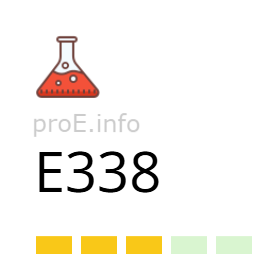
Other names for the additive (synonyms)
General Information
Phosphoric acid (food additive E338) is an inorganic compound, a weak triprotic acid, widely used in the food industry as an acidity regulator.
In nature, orthophosphoric acid is rarely found in its free form but occurs in the form of phosphates in apatite group minerals.
The chemical formula of additive E338 is H3PO4. In its pure form, it is a colorless hygroscopic crystalline substance that melts at temperatures above 42°C, turning into a viscous transparent liquid. In the food industry, orthophosphoric acid is used as an 85% aqueous solution — a thick, colorless, syrupy liquid without odor.
Main production methods of orthophosphoric acid:
- Reaction of calcium phosphate with sulfuric acid (wet process):
3H2SO4 + Ca3(PO4)2 = 2H3PO4 + 3CaSO4; - Hydrolysis of phosphorus pentachloride:
PCl5 + 4H2O = H3PO4 + 5HCl; - Combustion of white phosphorus followed by hydrolysis of its oxide:
P2O5 + 3H2O = 2H3PO4.
For the food industry, the wet process (sulfuric acid method) is predominantly used, as it is the most cost-effective and produces food-grade acid.
Effects on the Body
Benefits of additive E338
Orthophosphoric acid serves as a source of phosphorus — an essential micronutrient for bone tissue formation and normal energy metabolism.
According to the conclusion of the EFSA, orthophosphoric acid is considered safe when consumed within the acceptable daily intake (ADI) of 40 mg/kg body weight (calculated as phosphorus).
Risks of additive E338
Excessive consumption of orthophosphoric acid can disrupt calcium-phosphorus balance, promoting calcium leaching from bones, which increases the risk of osteoporosis. Some studies indicate a link between regular intake of beverages containing E338 and decreased bone mineral density. However, other studies have not confirmed this association.
Orthophosphoric acid contributes to the demineralization of tooth enamel, especially when combined with sugar, which provides a favorable environment for cariogenic bacteria. This is confirmed by numerous studies on the effects of soft drinks containing orthophosphoric acid on tooth enamel.
Since orthophosphoric acid has the highest phosphorus content among all phosphorus-containing additives, attention should be paid to the health risks associated with phosphate food additives, including:
- Hyperphosphatemia
Elevated phosphate levels in the blood disrupt mineral balance and provoke complications. - Vascular calcification
Calcium deposits in blood vessel walls reduce their elasticity and increase the risk of atherosclerosis. - Heart diseases
Excess phosphates raise the risk of heart attacks and heart failure. - Increased mortality
High phosphate levels are associated with increased overall mortality. - Calcium-phosphorus imbalance
Excess phosphorus reduces calcium absorption, leading to its leaching from bones. - Kidney stress
Phosphates increase kidney workload, especially in chronic diseases. - Arthropathy
Calcium pyrophosphate crystal deposition can cause joint inflammation. - Osteoporosis
Disruption of phosphorus-calcium balance weakens bones and increases fracture risk. - Increase in "bad" cholesterol
Excessive phosphate intake is linked to elevated LDL cholesterol. - Kidney stone formation
Calcium-phosphorus complexes may precipitate in kidneys as stones.
While it is evident that overconsumption of products containing additive E338 is undesirable, the European Food Safety Authority (EFSA) has not identified a direct health threat from orthophosphoric acid when consumed within the established ADI.
Uses
In food products, orthophosphoric acid helps regulate acid-base balance, inhibit the growth of pathogenic microorganisms, and stabilize flavor.
Additive E338 is significantly cheaper compared to other acidity regulators, such as citric acid, and is therefore widely used in mass-produced carbonated beverages.
Besides soft drinks, additive E338 is used in the food industry as:
- flavor and aroma corrector in confectionery products;
- crystallization inhibitor in the production of sugar syrups and condensed milk;
- anti-caking agent and stabilizer in powdered mixes.
Orthophosphoric acid is also applied in many other industries:
- in dentistry for enamel etching before filling application;
- in rust removal products (rust converters);
- in pharmaceuticals as an excipient;
- in cosmetics and chemical industries;
- in electronics for etching printed circuit boards.
Legal Status
Additive E338 is included in the list of permitted food additives in the European Union (Regulation EC No 1333/2008), where the acceptable daily intake (ADI) is set at 40 mg/kg body weight (as phosphorus).
In the United States, orthophosphoric acid is classified as GRAS (Generally Recognized As Safe) and is allowed without strict content limits according to FDA standards.
In Ukraine and many other countries, additive E338 is also officially permitted for use in food products, provided technical application standards are observed.